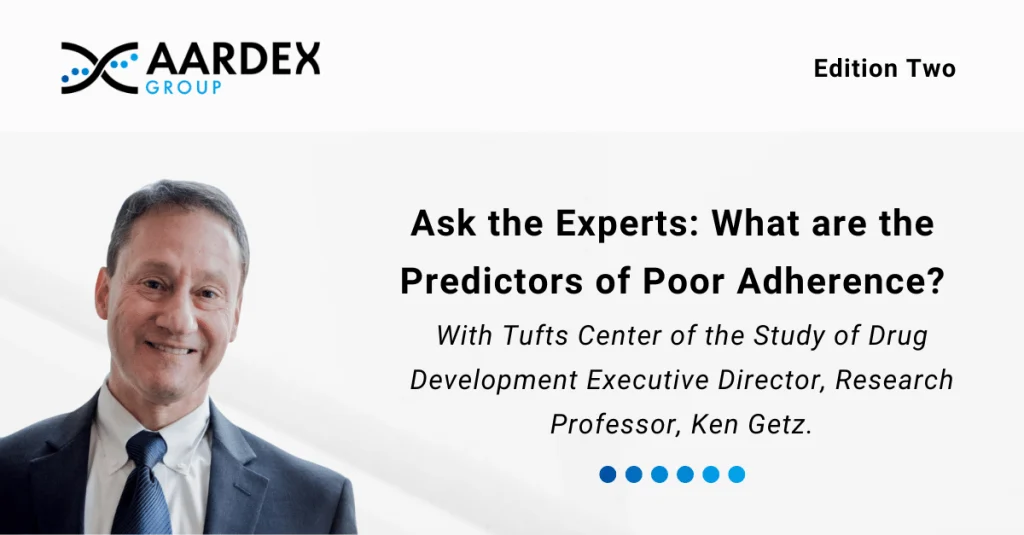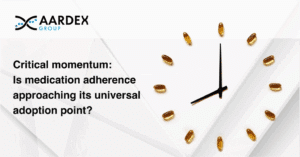In clinical trial analysis, it’s assumed that participants are following the instructions for the investigational product. Unfortunately, the evidence suggests that this is far from reality. Recently, Kenneth Getz, Executive Director and Professor at the Tufts Center for the Study of Drug Development, shared in a Q&A session with AARDEX Group how digitalization is finally exposing the persistent elephant in the room of clinical research.
What are the consequences of poor medication adherence during clinical trials?
Around 50% of clinical trial participants exhibit poor medication adherence,1 but this is just “the tip of the iceberg,” said Getz.
“We spend so much of our time focusing on the ‘upfront’ elements of our trials – on how we design our studies, how we manage their complex operation – but we often do not think about that last mile of will the patient adhere to the protocol. That is a massive problem,” he said.
In the absence of an adequate understanding of adherence, clinical teams may misjudge dose response. “When patients who don’t adhere to the protocol, we will tend to underestimate the drug’s safety and efficacy effects, and we may overestimate the dosage level.”
Non-adherence, he went on, can have “huge implications” for the understanding of a drug’s effect during development, and may even prevent the granting of a market authorization. Furthermore, it can also have “profound and devastating effects” on an approved product, that may ultimately need to be recalled.
Getz went on to say that clinical teams were aware of the non-adherence problem, and often inflated enrolment numbers, by an average of 15% to 20%, to offset the impact. “This tends to extend the duration of the trial and adds an estimated $2 billion-plus in additional recruitment fees. Lastly, it means we’re unethically exposing a larger number of patients to an investigational drug,” he said. “It is a massive problem.”
What are the predictors of poor medication adherence during clinical trials?
The root causes of poor medication adherence during clinical trials are numerous and complex, with a 2013 review finding more than 700 influencing factors.2 These broadly fall into five categories, as defined by the World Health Organization in 2003, of health system-, socioeconomic-, therapy-, patient-, and condition-related factors.3
Outlining the results of a 2020 review of 200,00 doses among 3,000 patients in 23 clinical trials, from the Tuffs Centre, Getz said: “Longer clinical trials tend to be positively associated with higher levels of non-adherence. This makes sense: patients may become tired within their trials, they may feel that study drug is either not addressing their symptoms, or, if it has reduced the severity of their symptoms, that they no longer need to adhere to the protocol. We also found that sites that are managing a higher volume of clinical trials tend to have higher rates of non-adherence, which may have something to do with staff having less time to continually remind patients of the importance of adhering to their treatment.”4
He went on: “If a patient took their first dose, they tended to match the overall level of dose adherence throughout the duration of the trial. But if they were intentionally non-adherent with their first dose, they tended to have five times the normal level of non-adherence throughout the life of the study, which is remarkable. There is a time-based quality here that allows us to predict non-adherence and, perhaps, intervene before the patient acts on that tendency.”4
How do advanced monitoring solutions differ from traditional methods?
For researchers to correctly identify early non-adherence, and respond to it appropriately, monitoring methods must be accurate. This is a challenge for traditional methods, such as pill count or self-report, as they are inherently open to bias.
“Historically,” said Getz, “we have had very poor levels of adherence measurement. The earliest studies used interviews and surveys, and that was very misleading.” While most people are “sincere in their desire to follow the protocol”, for those who are deliberately non-adherent would not admit to it, he went on.
Direct observation, in which a study team member watches a participant take their medication, has the potential to be accurate, but it is also costly to deliver. It also places additional burden on the patient just at a time when patient centricity is becoming an increasingly important factor in clinical trial design.
In recent years, advanced digital approaches have emerged. Medication Adherence Packaging, for example, records when a pill has been removed from a packet or bottle, and then uses statistical algorithms to flag missed doses or erratic dosing patterns. This allows study teams to risk stratify patients and deliver tailored interventions at any point during the study.
Studies have shown this solution to be 97% accurate in terms of correlating the opening of a smart pill bottle to dose injection. In addition, it is a frictionless solution, meaning that all the work happens in the background, and it asks no more of patients than they take their medicine.
Getz said such approaches were “addressing some of the problems that have prevented us from understanding, and acting on, this problem” in the past.
“With newer digital health solutions, we’re finally able to get a much more accurate read on the level of non-adherence,” said Getz. “We’re also gaining insights into ways that we can actually remediate and improve overall adherence in our studies, so it’s a really exciting time.”
What about accurate adherence measurement and regulatory approval?
Regulatory agencies “have also really got behind” the use of digital adherence monitoring and “are really encouraging its use”, Getz went on.
The Food and Drug Agency’s (FDA) 2019 Enrichment Strategies for Clinical Trials to Support Determination of Effectiveness in Human Drugs and Biological Products, for example, supports the use of smart pill bottles in trials.5
References
- Blaschke, T. F., Osterberg, L., et al. (2012). Adherence to medications: insights arising from studies on the unreliable link between prescribed and actual drug dosing histories. Annual review of pharmacology and toxicology, 52, 275-301.
- Kardas, P., Lewek, P., & Matyjaszczyk, M. (2013). Determinants of patient adherence: a review of systematic reviews. Frontiers in pharmacology, 4, 91.
- Sabaté, E., & Sabaté, E. (Eds.). (2003). Adherence to long-term therapies: evidence for action. World Health Organization.
- Getz, K., Smith, Z., Shafner, L., & Hanina, A. (2020). Assessing the scope and predictors of intentional dose non-adherence in clinical trials. Therapeutic Innovation & Regulatory Science, 54(6), 1330-1338.
- US Food and Drug Administration. (2019). Enrichment strategies for clinical trials to support determination of effectiveness of human drugs and biological products guidance for industry. Center for Drug Evaluation and Research (CDER).



